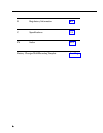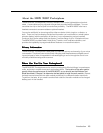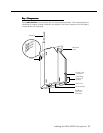
2-2
Installing the MDW 9030P Pocketphone
Guidelines for Safe and Efficient OperationGuidelines for Safe and Efficient Operation
Guidelines for Safe and Efficient OperationGuidelines for Safe and Efficient Operation
Guidelines for Safe and Efficient Operation
Your wireless telephone is a radio transmitter and receiver. When the phone is turned on,
it receives and sends out radio frequency (RF) energy. The phone operates in the fre-
quency range of 902–928 MHz. Your hand-held wireless telephone uses the digital TDD
mode. The power is transmitted in bursts at a 200 Hz pulsed repetition rate. The peak
envelope transmit power is 325 mW or less.
Exposure to Radio Frequency EnergyExposure to Radio Frequency Energy
Exposure to Radio Frequency EnergyExposure to Radio Frequency Energy
Exposure to Radio Frequency Energy
The design of your wireless telephone complies with the latest Institute of Electrical and
Electronic Engineers (IEEE) and the American National Standards Institute (ANSI) safety
levels with respect to human exposure to RF energy. Of course, if you would like to limit
RF exposure even further, you may choose to control the duration of your calls.
Cardiac PacemakersCardiac Pacemakers
Cardiac PacemakersCardiac Pacemakers
Cardiac Pacemakers
CAUTION:
The MDW 9030P handset is a radio device and, like all radio devices, should not
be placed next to a pacemaker.
Preliminary studies performed at the US Food and Drug Administration (FDA) and else-
where have shown that when digital cellular telephones are placed very close to im-
planted cardiac pacemakers, interference with the operation of the implanted pacemaker
can occur. These preliminary studies show that interference does not occur when there is
a reasonable distance between the telephone and the implanted pacemaker and stops
when the phone is turned off or moved so that it is more than 6 inches (15 cm) from the
pacemaker. Digital cellular telephones operate at .6 W. TransTalk wireless telephones
operate at a lower peak power of 325 mW or less (100 mW, on an average).
Until more is known, the FDA suggests that people with pacemakers may want to take
some simple precautions when using or carrying digital wireless telephones to ensure that
there is ample distance between the digital wireless thelephone and the pacemaker—by
not placing the phone next to the pacemaker implant (for example, in a shirt or a coat
pocket directly over the pacemaker implant) when the phone is on and ready to receive a
call and holding it to the ear opposite the side of the body where the pacemaker is
implanted when using the phone. Consult your physician or medical device manufacturer
to determine if additional precautions are necessary.
Hearing Aid CompatibilityHearing Aid Compatibility
Hearing Aid CompatibilityHearing Aid Compatibility
Hearing Aid Compatibility
Most electronic equipment, such as equipment in hospitals is shielded from RF energy.
However RF energy from wireless telephones may affect some electronic equipment.
Although the TransTalk wireless telephone is compatible with inductively-coupled hearing
aids, you should consult your physician or hearing aid manufacturer to determine if your
hearing aid is adequately shielded from external RF energy. The operation of inad-
equately shielded medical devices may be adversely affected when a portable wireless
telephone is operating in close proximity.
!


















